It’s That Time of Year — for the Harlingen Garden Show celebrating its Golden Anniversary. You don’t want to miss this two-day event!
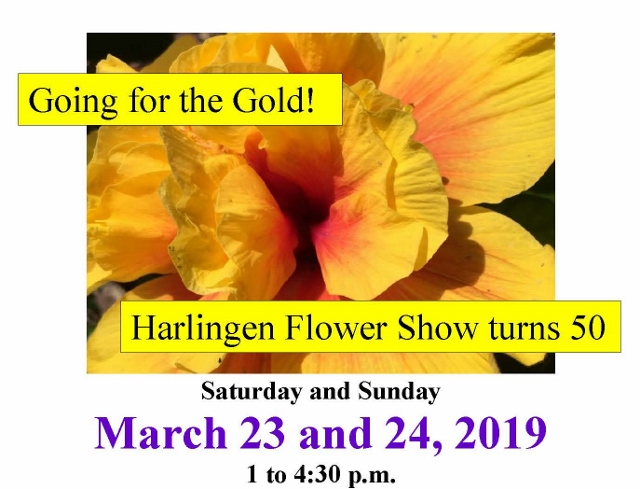
The flower show is at the Harlingen Cultural Arts Center — address: 576 ’76 Drive — next to the Harlingen Public Library.
Exceptional horticulture specimens will be judged and displayed. Floral Designs, Artistic Crafts and Houseplants also will be on display.
A special exhibit, Wild Native Blooms, showcases native Valley plants blooming now.
PowerPoint presentations are offered each day — get Advance Training or Continuing Education points.
Saturday, 2 p.m., Christina Mild presents “Edible Native Plants.”
Sunday, 2 p.m., Frank Wiseman presents “Landscaping with Natives to Attract Wildlife.”
Lecture seating is limited and available on a first come basis.
Christina and Frank are native plant specialists, knowledgeable Texas Master Naturalists and excellent presenters! They’ll share their many years of experience in promoting and establishing native species in their own home yards and elsewhere.
The flower show is open from 1 to 4:30 p.m. both days. Admission is free. Donations Accepted.
It’s That Time of Year #2
It’s time to begin thinking about the City Nature Challenge and iNaturalist.
Save these dates: April 26 to 29, 2019
This is the 4th annual City Nature Challenge. As with last year, the Lower Rio Grande Valley counties of Cameron, Hidalgo, Star and Willacy enter as its own entity.
For more information visit
https://www.inaturalist.org/projects/city-nature-challenge-2019-lower-rio-grande-valley
or Google one of the sponsors
- iNaturalist.org
- City Nature Challenge
- tpwd City Nature Challenge 2019
Download the iNaturalist app to camera-capable phones or check out the website.
Here is a list of what to photograph and upload:
Plants, trees, shrubs, animals, critters, vermin, fungi, slime mold, birds, bugs, insects, spiders, flies, wasps, Sea/Beach/Dune Life — ANY evidence of life, like, scat, fur, tracks, shells, snake skins, carcasses.
Start thinking about the challenge now and practice using the phone app (you’ll need your phone password to download the app) or open an
Training sessions for installing and using the app and uploading via the Internet are being scheduled. Training information will be sent via a multitude of venues.
Why this City Nature Challenge is important to the sponsors and residents of the Valley is not primarily because it’s a competition — it’s a valuable data base of the Valley’s native habitat. And, it IS a competition — who doesn’t like a challenge, right? There are three levels in the competition.
- most observations (of nature)
- most individual species
- most people participating
The Valley is in competition with cities around the world and still, the Lower Rio Grande Valley placed a spectacular 10th in the global City Nature Challenge bioblitz in 2018! That’s pretty awesome!
Here’s a recap of the 2018 City Nature Challenge
The four counties of the Lower Valley, Cameron, Hidalgo, Star and Willacy, entered as one entity and placed 10th for most observations, 15th for most species and 26th for most observers with 194 participants who photographed nature and uploaded the images to the Texas Parks and Wildlife Nature Tracker Website, iNaturalist.
More than 50 Lower Valley Texas Master Naturalists were included in the 194 count. Eight of the top ten observers and species contributors were from the Valley’s two Texas Master Naturalist chapters.
The total observations from the Lower Rio Grande Valley was 8,758; number of species 1,664.
If you’re interested in joining the challenge, those tasked with helping to ID and verify the thousands of entries that populated the site offer some practical advice for us photographers who will be entering species onto the iNaturalist website. These recommendations are meant in all kindness. Following them will help ensure your uploads will be useful. I know I took a couple of photos that even I couldn’t remember what I was trying to depict — especially when there were six different species in the same photo and all seemed to be of the same color of green
Recommended photography pointers
— to help Identifiers identify species from photographs
- Keep a white card with you about 8 ½ by 11 inches. Place card behind plant species if plant is among a tight growth of vegetation. This will single out item to be identified. Or use a light colored hat as background.
- If guinea grass or other invasive vegetation obscures object you want to photograph, pull, push or trim invasive species before taking photograph.
- Ensure photos are sharp and crisply focused. Keep phone camera lens at least 6 inches from subject. Hold camera or phone completely still so camera shake doesn’t blur the end result. Take several photos and edit them later.
- Try to capture both bloom and leaf in photo. If there are mature fruits or seedpods on plant or beneath it, or thorns on trunks, capture those also.
- If multiple photos are taken to ensure proper
identification, upload all photos to one observation entry.
- Taking one photo of an entire shrub or tree shows growth form but not enough detail to make an ID.
- Take additional photos to show details of foliage, blooms, stem and other features that will help identify a species from a photo.
- A white or light colored 6-inch ruler in the photo helps show scale. Or drop a coin near the subject, or your hand or foot. The object needs to be something that can give a relatively true perspective.
- Learn
the editing features on your phone. On some phones, it’s easy to crop out
irrelevant things, keeping only the object you wish to submit.
- You also can change the lighting using the phone’s editing features, which often helps to better visualize things.
- A wide-brimmed hat is handy to shade cellphone or camera screen to help show if shot is in focus.
- If there is too much light on white or yellow blooms, they will be obscured. Someone can hold an umbrella overhead or position their body to put the object in shade. It’s best to have the sun at your back, rather than taking a photo facing into the sun.
The below two photos were not good candidates to submit:
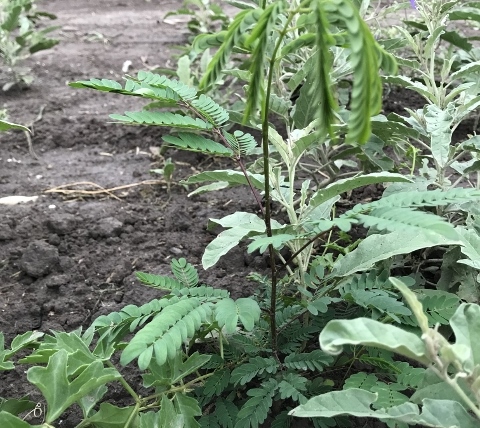

Where as the below Red Poppy, Argemone sanguinea, white-flowering form, if not completely in sharp focus, enough detail is present in the leaves and seedpods to promote identification.
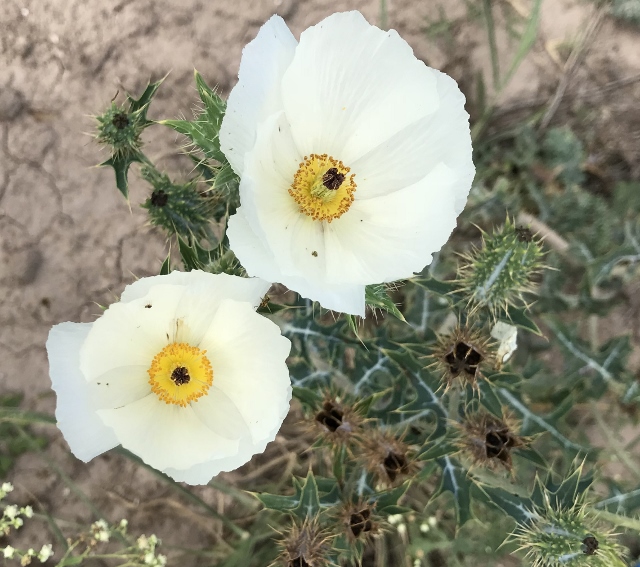
The nutria below was a surprising shot taken at dusk; good to use once I lightened it up in the computer.
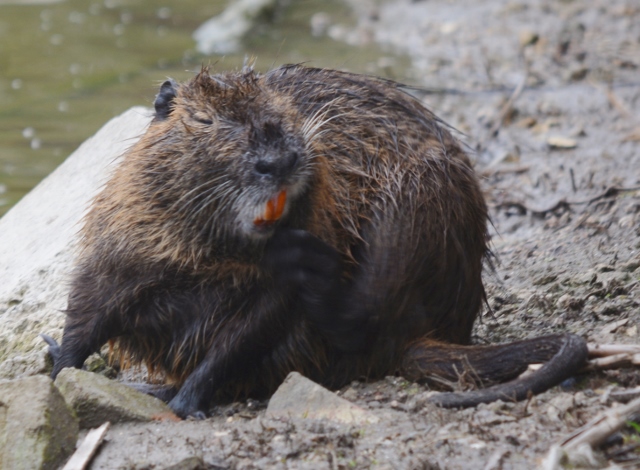
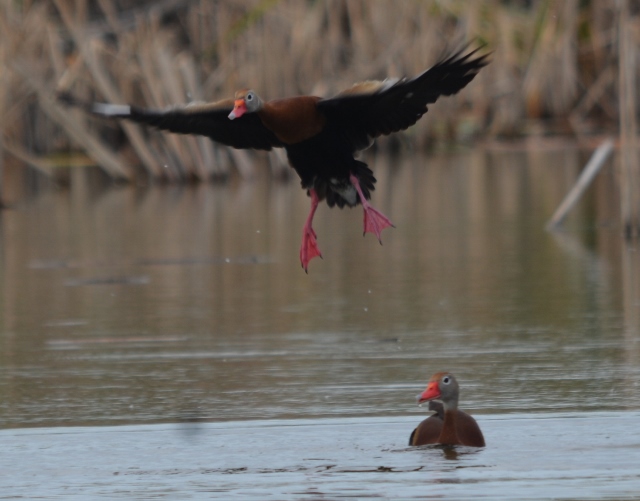
The four days I spent in nature during the 2018 BioBlitz were really uplifting and relaxing. The first day I stayed around our acreage, and that evening and early next morning photographed at the resaca. The second day I went to Boca Chica beach and dunes; the third day, my farmer-neighbor let me go around the edge of his fields, adjacent to the forest in back of our property; the last day, I scootered around a mile track in back of our property. It helped that the weather was glorious!